Red-eared sliders are popular beginner turtles as they are cute and easy to keep. But, many first-time keepers struggle to feed them a proper diet.
Many people know that turtles eat vegetables and meat. Yet, they do not know that the portions of vegetables over meat you should feed must change as they grow.
In this article, we discuss what red-eared sliders eat and share the best foods, feeder fish and diet.
We also share common feeding mistakes, overfeeding and why you should not power feed. Finally we give some tips on why a red-eared slider diet is different for a baby than adult, as well as how to feed them…
What Do Red-Eared Sliders Eat?
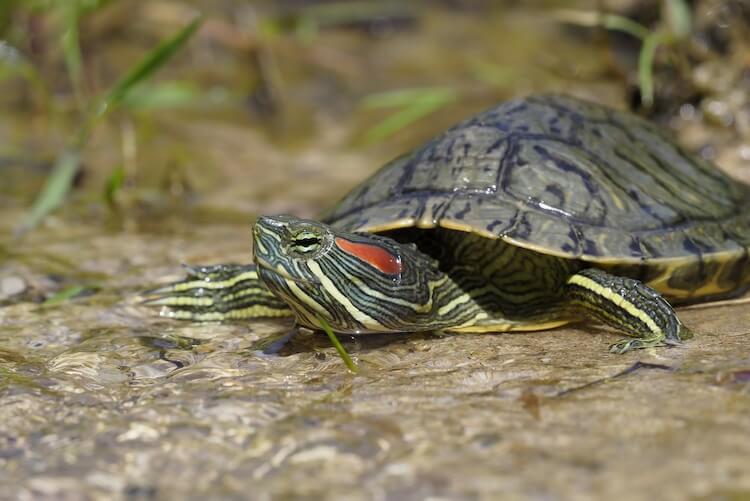
Red-eared slider turtles are omnivores, so they eat both plants and animals.
Adults mostly eat aquatic plants such as elodea, duckweed, water lettuce and water ferns. Adults eat so many plants they are considered herbivorous. They will only eat meat if it is readily available and there are no plants nearby. Sometimes adults will eat small fish, earthworms, redworms, insects, snails, slugs, tadpoles and frogs.
Baby red-eared sliders eat much more meat than adults. Meat gives younger species the extra protein that is needed to help them grow and develop their shell. Babies enjoy invertebrates, very small feeder fish (e.g. minnows) and worms.
As they age this species does not need as much protein.
Too much protein in adults can cause an issue known as shell pyramiding, which is when the shell becomes more triangular in shape.
Red-eared sliders hunt by either sitting motionless, waiting for a fish to swim by and then snatching it, or by chasing and snapping up any bugs that land in the water. Adults will also swim along the bottom of ponds or lakes and eat aquatic plants or algae.
Hunting and foraging for food uses up a lot of energy, so they normally eat multiple times a day.
Turtles in the wild will eat whenever they can. However, pet sliders should only be fed every two to three days because they do not have to hunt.
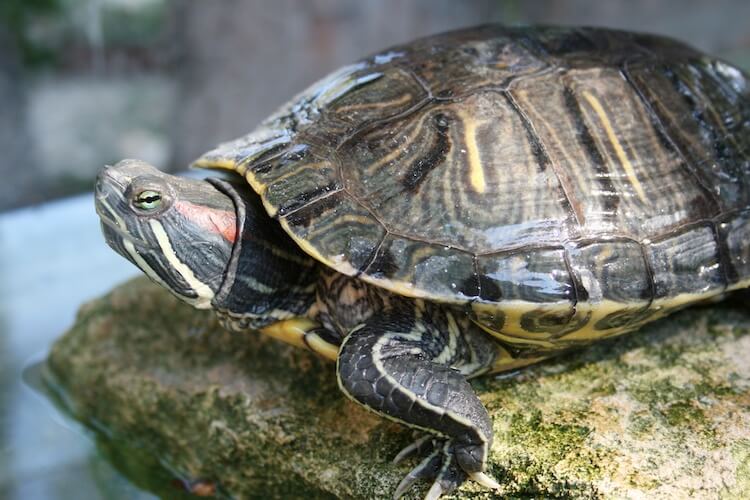
Red-Eared Slider Diet
Feeding red-eared sliders a balanced diet is vital for their health.
Many turtles will stop eating out of boredom if they are fed the same diet. Providing a variety of foods in their diet is key to keeping a healthy appetite.
Adult red-eared sliders can be fed:
- Dark leafy greens: romaine lettuce, kale, dandelion greens, turnip greens, mustard greens, or swiss chard.
- Vegetables: bell pepper or carrots.
- Feeder fish: goldfish, guppies or minnows.
- Insects, earthworms, slugs, snails or tadpoles.
Feeder fish are good enrichment for turtles as they will have to chase it down to catch it, but they can also contain parasites. If you decide to feed feeder fish then buy them from a local pet store. You should never feed wild-caught prey.
In addition to a healthy diet, your turtle will also need a calcium supplement.
A powdered calcium supplement that also contains vitamin D3 is the best. This calcium supplement will help prevent diseases and shell deformities. Another option is to throw in a cuttlebone once or twice a week.
It is important to know that a red-eared slider’s diet changes as they age. Baby red-eared sliders need a diet that is higher in meat and protein. Babies should be offered some vegetables, but the majority of their diet should be carnivorous.
As your red-eared slider ages you can begin offering less feeder fish or insects and replace it with a variety of vegetables or aquatic plants.
Baby Red-Eared Feeding Schedule
Baby red-ears need to be fed much more frequently than adults. They also need a diet high in protein. Babies should be fed every day as they need a tremendous amount of energy to grow at the proper rate.
Make sure you offer a red-eared slider diet that consists of:
- Dark Leafy Greens
- Vegetables
- Aquatic Plants
- Feeder Fish
- Feeder Insects
- Worms
- Commercial Turtle Pellets
An equal mix of protein-rich food items, dark leafy greens, and vegetables is ideal for a baby red-eared slider.
Their diet should be 30% plant based and 70% meat.
Any vegetables you feed should first be boiled and chopped into pieces small enough to fit into the turtle’s mouth. Let your turtle have a 15 minute feeding session. After the feeding session, just remove anything that hasn’t been eaten to keep the water clean.
Use a feeding schedule to track what you are feeding in the event that your turtle becomes sick. You can find a good feeding schedule below:
| Day | Food |
|---|---|
| Monday | 3-4 small feeder fish, Small handful of mustard greens, Pinch of turtle pellets. |
| Tuesday | 3-4 earthworms, Small handful of kale, Half of a chopped carrot, Calcium supplement. |
| Wednesday | 2 redworms, 3-4 crickets or mealworms, Small handful of baby spinach, Half a chopped bell pepper. |
| Thursday | 3-4 small feeder fish, Small handful of kale, 2 small worms. |
| Friday | 3-4 large worms, 3-4 crickets/mealworms, Small handful of spinach, 1-2 blueberries. |
| Saturday | Turtle food (follow feeding instructions on container), 2-3 insects, Small handful of swiss chard. |
| Sunday | 5-7 crickets/mealworms, 1 earthworm, Half a chopped bell pepper, 1-2 turnip green leaves. |
Adult Red-Eared Slider Turtle Feeding Schedule
Adults should be fed a hearty amount of food once every two days.
A big handful of leafy greens, a pinch of turtle pellets, and a couple worms or insects should be plenty. Adults eat a lot less meat, so make sure you offer plenty of dark leafy greens, vegetables, and aquatic plants.
Foods rich in protein, such as fish and invertebrates, should only be offered once a week.
To prepare vegetables for feeding, you should first boil them until they are soft enough to be easily pierced by a fork. This will help remove any bacteria or bugs and will also soften it to make it easier for your turtle to eat.
Their food can be shredded and offered all at once. You should be sure to remove any food that does not get eaten after 15 minutes to ensure that your water stays clean.
A varied diet will keep your turtle healthy and will make sure they don’t get bored and stop eating.
| Day | Food |
|---|---|
| Monday | Large handful of kale, One chopped carrot, One chopped red bell pepper, Calcium supplement. |
| Wednesday | Large handful of kale, Two earthworms, Two minnows, Pinch of fish food pellets. |
| Friday | Large handful of kale, 2-3 aquatic ferns, 1-2 blueberries, Pinch of commercial turtle food, Calcium supplement. |
| Sunday | Large handful of kale, One chopped carrot, Small handful of chopped swiss chard. |
Most keepers choose staple foods that they rotate every week. For example, you can choose kale as a staple green for one week, and then swap between supplementing with bell pepper, carrots, earthworms, a couple of minnows and turtle pellets.
Red-Eared Slider Food
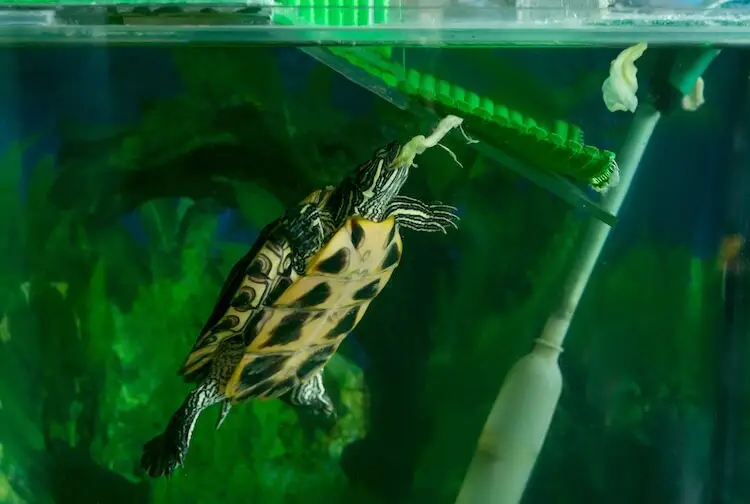
Red-eared sliders are omnivorous so they can eat both plants and animals.
- A baby red-eared slider’s diet should be about 70% meat and 30% plant.
- Adults should eat a diet of 50% meat and 50% plant.
An adult red-eared slider’s diet consists of so much plant matter that they are considered primarily herbivorous. This makes feeding red-eared sliders a varied, enriching diet simple.
The plant portion of the diet should largely consist of vegetables and aquatic plants.
For any age slider, it is a good idea to stock their tank with aquatic plants that they can munch on if they are hungry after feeding, maybe even add a few freshwater fish or shrimp too.
The animal portion of the diet should be invertebrates, worms, or commercial fish food. Feeder fish are good for making your turtle exercise, but they are often high in fat and can carry bacteria or parasites.
Below is a complete list of foods safe for red-eared sliders to eat:
- Crickets
- Mealworms
- Minnows
- Tadpoles
- Frogs
- Earthworms
- Redworms
- Feeder goldfish
- Waxworms
- Aquatic snails
- Bloodworms
- Daphnia
- Shrimp
- Water ferns
- Duckweed
- Elodea
- Romaine lettuce (in small amounts)
- Kale
- Mustard greens
- Turnip greens
- Swiss chard
- Bell pepper
- Carrots
- Carrot tops
- Zucchini
- Cucumber
- Squash
- Corn
- Okra
- Celery
- Green beans
- Cactus
- Commercial fish food
- Commercial turtle food
What Vegetables Can Red-Ear Turtles Eat?
Vegetables are an important part of a red-eared slider’s diet. As adults they eat a lot of plants so they get bored of a repetitive diet. Offering a variety of vegetables keeps your turtle interested in eating. Here is our favorite list of vegetables you can safely feed red-eared sliders:
- Bell peppers
- Carrots
- Cucumbers
- Zucchini
- Celery
- Squash
- Green beans
- Corn
- Okra
- Cactus
There are some vegetables you should avoid such as broccoli, peas, cabbage, and brussels sprouts as they can all cause gout.
What Fruit Can Red-Ears Eat?
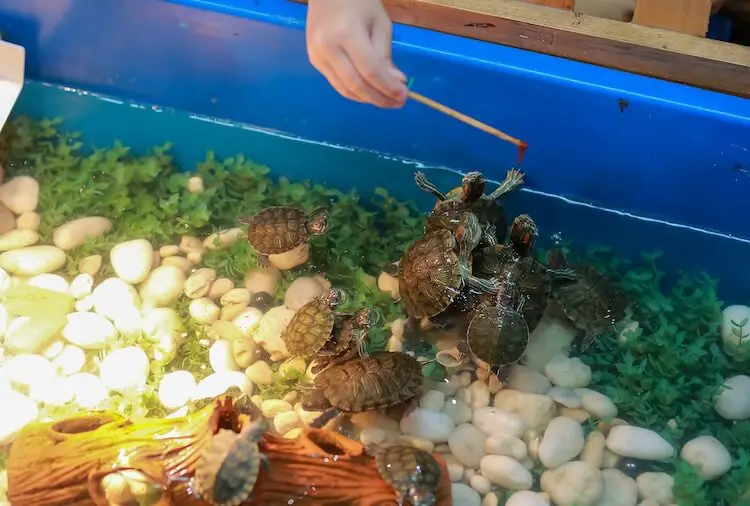
Red-eared or yellow-bellied sliders should not be fed fruit as a major part of their diet, but it is fine to feed fruit occasionally as a treat. Wild sliders do not normally eat fruit, so their bodies are not capable of digesting the high amount of sugar it contains.
Feeding red-eared sliders too much fruit can cause diarrhea.
They should be offered just one or two pieces a week. Here is a list of fruits that can be fed as a treat:
- Watermelon
- Strawberries
- Bananas
- Pears
- Mangos
- Grapes
- Tomatoes
- Apples
- Blueberries
- Blackberries
- Raspberries
- Plums
- Star fruit
- Cantaloupe
- Kiwi
Common Feeding Mistakes
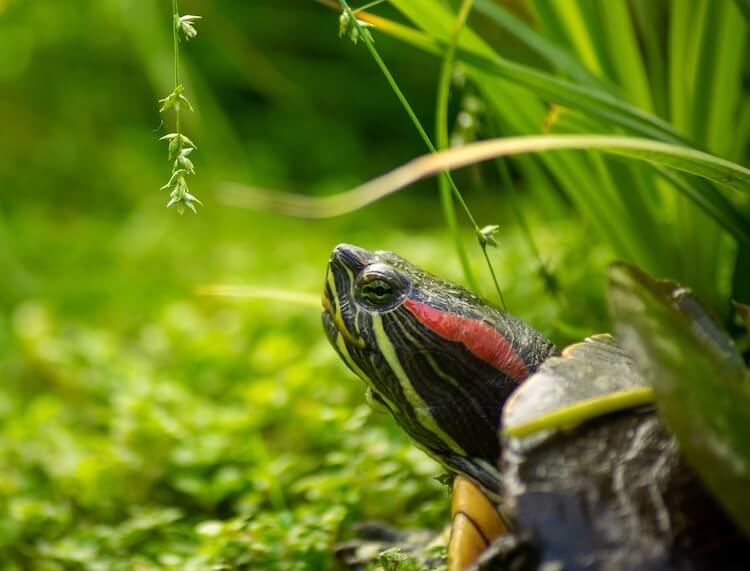
Turtles and many other animals tend to move slower after eating, so regurgitating food in order to escape more quickly is a common tactic.
Red-eared sliders may regurgitate their food if they are handled too soon after eating. For this reason, you should wait five hours after feeding before handling. This will give your turtle time to digest its food.
Five hours should be enough so that your turtle will no longer feel vulnerable.
Red-eared sliders can also be prone to overeating.
If your turtle weighs more than 6 pounds, it is probably eating too much. Other signs of obesity include lethargy, bloating, or shell disfigurements. Obesity causes many health issues, including fatty liver disease, heart issues, diabetes, and arthritis.
You should also never power feed a slider. Power feeding can cause a host of health issues and obesity. Power feeding is purposeful overfeeding normally done by irresponsible breeders so that they can sell or breed their turtles as quickly as possible.
Many first-time keepers think that you should move your turtle to another enclosure to feed them.
The idea is that your turtle will not associate your hand reaching into the tank with feeding, but this is a myth. It does have the benefit of keeping the main tank’s water cleaner, but it is easy to remove any uneaten food and use a tank filter.
Moving a turtle to a separate enclosure to feed them causes unnecessary stress and should be avoided whenever possible.
Foods They Cannot Eat
The diet for a red-eared slider should be varied, however there are some foods that should be avoided.
One food you should avoid is any member of the Brassica family. This includes broccoli, cabbage, brussel sprouts, and bok-choi. In excess, these foods can cause kidney problems and interfere with calcium absorption.
You should also avoid foods like radishes (they contain goitrogens), soybeans, avocado, dairy, any foods high in fat and any human food. All of these foods can make your pet turtle sick with diarrhea.
Here is our complete list of foods you should avoid feeding a slider turtle:
- Broccoli
- Cabbage
- Brussel
- Bok-choi
- Radishes
- Soybeans
- Avocado
- Dairy
- Food high in fat
- Human food
- Wild caught prey
Summary
Red-eared slider turtles are omnivores, so they will eat both plant and animal matter. However, as they age, they need less protein.
Adults should be fed a diet of 30% meat or protein and 70% plant matter, and babies should be fed a 50/50 diet of plants and meat.
Good plants to feed red-eared sliders are dark leafy greens, aquatic plants, and vegetables. Feeder fish, invertebrates, and commercial turtle pellets are good sources of protein.
Make sure your turtle is also getting a calcium supplement at least once a week and is not being handled after feeding.
Let us know what your turtle eats in the comments below.

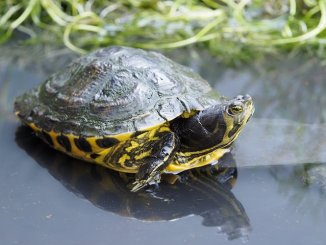
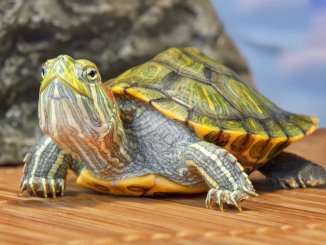
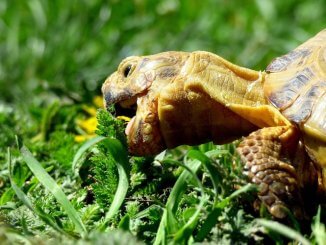

Very Informative!🤟
What is the correct age to feed them veggies ? , because my turtle is three years now
May be unrelated, but do you know anything that will make the glass on an old mistreated aquarium shine?
Thank you so much. This is a great guide for me to use to feed my red eared slider!
If it is on the inside & kind of hazy when dry then it sounds like hard water deposits. If you empty the entire tank, you might be able to get rid of it by soaking in vinegar or soaking a towel or or clean tee shirt in vinegar & letting sit there for a day or two, making sure it doesnt dry out. After letting soak awhile, I will either use a razor blade or magic eraser (only if glass tank). If it is really set in, sometimes that doesnt even work though & your just kind of stuck with it. You will be able to feel with your finger if it worked because it will be smooth. Be careful with the razor, keep it at about a 45 degree angle or less when scraping & dont scrape the glue at the seems. Rinse tank well before resetting up with water.
Vinegar
What is the least expensive turtle canister filter, that can clean a 60 gallon tank. Thank you
Keep in mind that GPH (Gallons per hour) should be 2 to 3 times the size of your tank. A good option on the cheaper end would be ReptoFilter, which is easy to install and clean, and even comes disguised as a rock.
My turtles eat lizards that we find in the house, is that ok?
Wild animals are often advised against and certainly shouldn’t be the only food source. They could have parasites or pesticides build-up in their bodies. However, this is true for animals coming from low-quality breeders too, so it is not a matter of death sentence v total safety.
Eating lizards, although not the strangest of dietary choices we’ve heard of, is a bit strange nonetheless. It could be that your turtles lack some proteins in their diet and are getting it from lizards, but you can provide them with safer and more natural protein sources such as guppies, minnows or earthworms.
I have a problem with my indoor kiddie pool getting very smelly quick. Within a day of total cleaning. I tried putting them together n a different tub to eat, but all they do is try to get out and are oblivious to the food I give them. What do I do?
Sorry, I have 2 red ear and yellow eared sliders – 2 one each. About 4-5 inches across the shell
If the tank smells only one day after cleaning, it might be that you have to change your water filter. Material can accumulate in the filter, so no matter how much you wash the tank, it is going to smell.
In terms of feeding, remember young turtles are less inclined to eat greens and will happily fed on earthworms and other animal protein. Only as you go along you may switch their diet to leafy greens and other vegetables. Hope this helps!
Is there anyway you can send me a list of all a red ear slider can eat
All you need to know is in the article you commented! We hope it helps
What about an occasional mandarin orange or any other type of orange?